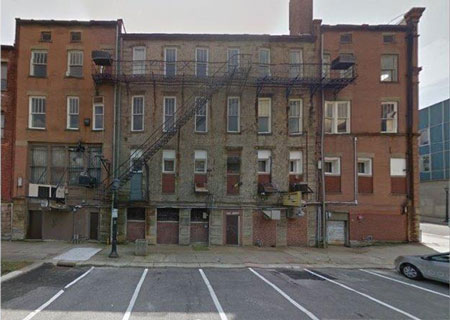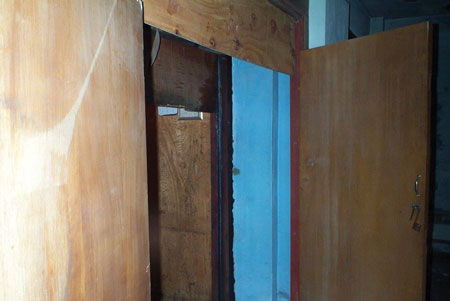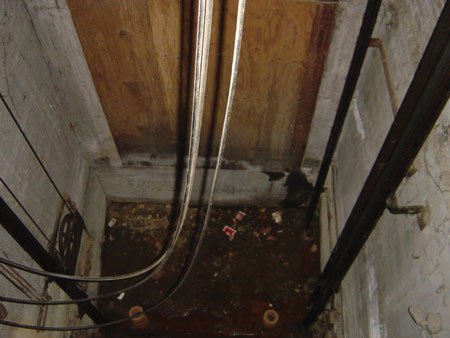
By JOSEPH PRONESTI
It can be “fool’s gold” to believe that your three- or four-member rapid intervention team (RIT) will suffice when combating a fire in a group of attached structures of ordinary construction. Let’s compare how most smaller departments handle RIT at a typical residential fire vs. a three-story building of legacy construction.
Deputy Chief (Ret.) Anthony Avillo, North Hudson (NJ) Regional Fire and Rescue, has stated that fires in continuous structures can be a “manpower sponge.” A working fire in a commercial building (especially one at the middle of a block) has the potential to spread, necessitating double the number of firefighters on scene as compared to a fire in a residential building. Also, depending on the size of your department, several departments may be on scene. So, how are the two responses – to residential vs. commercial buildings – different?
The Building
The layout of most residential structures is relatively straightforward; a four-member RIT can provide a quality fire attack. Under normal circumstances, these crews can soften the building prior to an event by throwing ladders, increasing scene lighting, and so on. However, you may face many obstacles when attempting to get these crews from the A side (photo 1) of your “Main Street” building to the C side (photo 2). We work in a world of residential house fires, and when confronted with the commercial fire, the “square peg in a round hole” approach to RIT can give command officers a false sense of security. This article is not intended to be a RIT procedure guide. Many articles and periodicals exist on the subject, but few focus on commercial (legacy) buildings and the nuances they present. A RIT leader must have a fundamental understanding of Type III construction and its fire spread potential, which can be rapid, go in any direction, and lead to collapse. The engaged RIT officer will be well ahead of the curve and possess the same pessimistic mindset that command must also share. In a residential fire, we are dealing with a single structure; the RIT boss on Main Street may have a serious vacant storefront fire with occupied apartments above extending to, say, a furniture store, each with possibly dozens of firefighters inside.
 |
| (1, 2) Having a one-size-fits-all rapid intervention team (RIT) for all structures to which you respond, especially for these Type III ordinary buildings, may set up a department to fail. (Photos by author.) |
The Common Hazards
As with any fire, the hazards RITs may face and from which we may need to be rescued are numerous, so let’s narrow them down to some common hazards noted in the National Fire Protection Association’s 2014 Firefighter Fatality Report.
In 2014, stress and exertion/medical was at the top at 58 percent. If we exclude crashes and focus on fireground fatalities, the next four hazards in order of probability were the following:
- Rapid fire progression: 8 percent.
- Lost/disoriented inside the structure: 5 percent.
- Falls: 5 percent.
- Structural collapse: 3 percent.
Stress and Exertion/Medical
A RIT crew that is activated for a medical event may be faced with moving a down firefighter up from commercial basement stairs or down constricted hallways or stairs from upper floors – two distinct features of “Main Street” buildings. One location on the residential structure not always considered during an emergency is the roof because of the building’s legacy construction; roof operations are usually needed here because the roof is a common work area during a fire.
So, how would a RIT move a down firefighter who has suffered a stroke or a heart attack on the roof? Can you get the proper litter to the roof? If you have only an aerial on scene, can you get that member down safely? Because of these questions, you must be prepared and review training for removing a down firefighter on a ladder (aerial or ground), which departments sometimes neglect. Also, many C sides of Main Street buildings feature large electric transmission lines not normally found in residential buildings, setting up the potential for electrocution.

Lost/Disoriented
“Negative, Command. I can’t do it, have stuff all over the line, and I am disoriented on I … please send help.”
Unfortunately, this was the last radio transmission from Bryan (TX) Fire Department Lieutenant Eric Wallace, who died in a commercial building fire on February 15, 2013. We have all had that moment of disorientation in a residential house fire, but has it happened in a cluttered commercial basement or a large studio apartment on the second or third floor of a downtown building? As a RIT crew, what is your plan to traverse through uncommonly found obstacles to get to the down firefighter? Does your RIT rope bag feature pretied knots to indicate the distance traversed and to identify the direction to and from your entrance point? The tie-off point – a series of knots tied onto the rope – should be done with 25-foot intervals between each knot, progressing to seven knots at 175 feet. Air supply will also become an issue; needing to get air to one firefighter is one possible scenario, but it could also become two or more firefighters needing air. Fires in smaller towns will amass a large contingent of firefighters from several departments. RIT crews must be adept at getting air to different brands of self-contained breathing apparatus.
Falls
You will not find legacy exterior fire escapes on residential dwellings; they will most likely be on Type III multistory buildings. A proactive RIT can illuminate the building and scan fire escapes for any hazards prior to a response, especially if the fire escapes are needed during an emergency egress or evacuation. When illuminating the building, focus on parapets and cornices. A RIT’s duties will cross over to the duties of the safety officer, but most small departments assign RIT prior to assigning a safety officer, thus gaining more eyes on the building for safety.
Structural Collapse
The fire service has done well educating its members in and recognizing today’s preengineered construction and the inherent structural hazards of Type II noncombustible buildings. However, many firefighters are still encountering near misses or worse in Type III building collapses, the most recent being a line-of-duty death (LODD) in Kansas City, Missouri, in October 2015. A structural collapse on the fireground is the most difficult to control from accountability and rescue standpoints. Collapses of these Type III buildings occur mostly involving the parapet and outside walls. A RIT must focus on the building prior to the event, especially on structural cracks, smoke, water seeping through walls, and so on. We usually do not measure the amount of water we use on the fireground; pouring hundreds of gallons of water on top of and around a building and then sending in the “troops” can be a neglected safety issue. Most deadly collapses have occurred during the overhaul stage, a prime example of which is the 1972 Hotel Vendome fire in Boston, Massachusetts, that claimed the lives of nine firefighters.
 |
| (3, 4) Do not assume that all members on the fireground will recognize hazards such as outward-swinging doors leading to shafts. Educate your members on the typical hazards found in legacy Type III buildings. |
The RIT Line
Few, if any, departments’ RIT guidelines and procedures discuss their RIT using a separate line. In the Bryan, Texas, LODD after action report, the use of a RIT hoseline is mentioned as a new standard to be adopted by the department. If a collapse or rapid fire event occurs and traps firefighters, a deployed, charged hoseline will be the fastest method of getting water on the fire and away from the trapped firefighters. A RIT should have this line at the ready during a working commercial fire on Main Street or any other construction type.
Chief Officer Positioning
A good commander will get chief officers into position at a Main Street fire. Recently, I was teaching a class on Type III firefighting, and we spent a lot of time debating the use of company officers as sector bosses. A company officer (especially in a smaller suburban setting – paid or volunteer) is focused strictly on commanding/overseeing two or three members. When he is asked to oversee an entire area, we cannot be sure he has had the training or focus to see the entire picture – i.e., collapse issues, smoke, fire spread, accountability, and so on. The same can be said for a RIT at a large event. Add a chief level officer to oversee RIT just as you would to the roof, interior, and exposures.
One Block, Two Sides, Two RITs
“Command, we have a firefighter in trouble on the C side; we need RIT deployed now!” These are words you never want to hear, but if you hear them, think about the logistics and time it would take to get the RIT from the A side – where you most likely stage your RIT – to the C side. Most Main Street structures of legacy construction feature alleys at the rear, and we most likely have companies operating on the C side to begin with. So, think about doubling your RIT by having a team staged on the A and C sides.

Setting Up the Aerial
Most smaller departments do not have full-time positions on their truck companies. Some mutual-aid companies may not even have an aerial, so what do you do if you need RIT to set up the aerial to get a firefighter out of a third-floor window? Train all firefighters in the use of your department’s aerial apparatus, conduct training with your mutual-aid departments, and review each other’s equipment and apparatus. As a chief, you will not want to explain to the widow of a firefighter why you couldn’t get the aerial to her husband in time.
Rescuing the “Bull”
Like most of us, Alan “The Bull” Dugan of the Grandview (MO) Fire Department went to work on October 5, 2015. However, within the first few hours of his shift, his department was called to a fire in a two-story downtown building with as many as four civilians reported trapped. The building housed retail businesses on the first floor and seven residential apartments on the second floor. The “Bull” crew arrived and began immediate search operations. Police officers had already removed one trapped occupant, but more were reported inside. At 1003 hours, a ceiling collapsed on the second floor, trapping Dugan. He radioed a Mayday, and he was successfully rescued. The rescue was recorded by a citizen, and the video went “viral,” showing his aerial apparatus operator climbing the ladder to rescue him. It was a successful outcome to a possible tragedy.
A well-thought-out RIT and understanding the differences between a “residential” and “Main Street” RIT may one day help you save a life.
JOSEPH PRONESTI is a 28-year veteran of and a shift commander for the Elyria (OH) Fire Department. He is a graduate of the Ohio Fire Chiefs’ Executive Officer program and a lead instructor at the Cuyahoga County (OH) Community College Fire Academy. Pronesti is also a contributor to fire service publications and sites including Fire Engineering, FireEngineering.com, and FirefighterNation.com.
Are You Prepared for a Fire on Your Town’s Main Street?
Be Ready for the “Big One”
Lost in the Fog of the Fireground
Fire Engineering Archives

